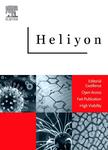版权所有:内蒙古大学图书馆 技术提供:维普资讯• 智图
内蒙古自治区呼和浩特市赛罕区大学西街235号 邮编: 010021

作者机构:University of Babylon College of Engineering Mechanical Engineering Department Iraq Power Mechanics Engineering Department Al-Musaib Technical College Al-Furat Al-Awsat Technical Babylon Hillah Iraq Department of Business Administration College of Administrative and Financial Sciences Cihan University-Erbil Iraq Department of Mechanical Engineering University of Al-Qadisiyah Ad-Diwaniyah 58001 Iraq College of Engineering University of Warith Al-Anbiyaa Karbala Iraq Department of Mechanical Engineering University of Al-Qadisiyah Al-Qadisiyah 58001 Iraq Department of Computer Network College of Engineering and Computer Science Lebanese French University Kurdistan Region Erbil Iraq Department of Mechanical Engineering College of Engineering University of Bisha P.O. Box 551 Bisha 61922 Saudi Arabia Biomedical Engineering Department College of Engineering and Technologies Al-Mustaqbal University Hillah Iraq
出 版 物:《Heliyon》 (Heliyon)
年 卷 期:2025年第11卷第1期
页 面:e40960页
主 题:Casson-based nanofluid Corrugated cylinder Cu-H2O nanofluid Free convection Heat transfer enhancement Semi-parabolic enclosure
摘 要:The optimization of heat transfer in various engineering applications, such as thermal management systems and energy storage devices, remains a crucial challenge. This study aims to investigate the potential of Casson-based Cu-H2O nanofluids in enhancing free convection heat transfer within complex geometries. The research examines the free convection heat transfer and fluid flow characteristics of a Casson-based Cu-H2O nanofluid within a semi-parabolic enclosure that includes a wavy corrugated cylinder. Utilizing numerical simulations based on the Galerkin Finite Element Method, the study investigates the impact of different factors, including the Rayleigh number (103 ≤ Ra ≤ 106), Casson fluid parameter (0.1 ≤ γ ≤ 1), corrugation number (3 ≤ N ≤ 10), nanoparticle volume fraction (0 ≤ ϕ ≤ 0.15), and enclosure inclination angle (0° ≤ ζ ≤ 60°), on both heat transfer efficiency and flow patterns. The results reveal that increasing the Rayleigh number and Casson fluid parameter enhances heat transfer performance, with the average Nusselt number increasing by up to 165 % as Ra increases from 103 to 106. An optimal range of corrugation numbers is identified for maximizing heat transfer at higher Rayleigh numbers. The addition of nanoparticles significantly improves heat transfer, with a 20 % increase in the average Nusselt number observed at Ra = 105 when the nanoparticle volume fraction increases from 0 to 0.15. These findings provide valuable insights for designing more efficient thermal management systems in applications such as electronics cooling, solar thermal collectors, and heat exchangers, potentially leading to improved energy efficiency and performance in various industrial and technological sectors. © 2024